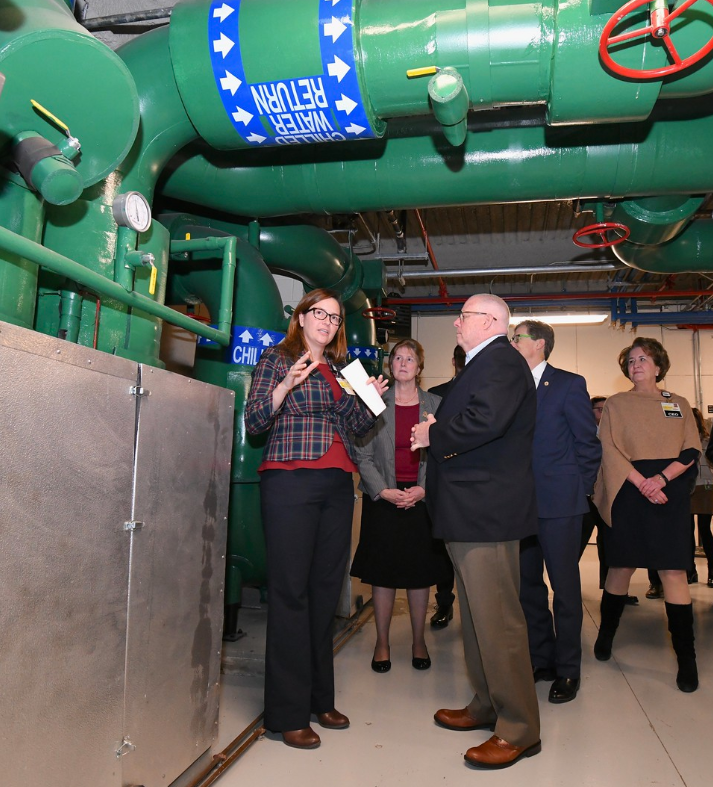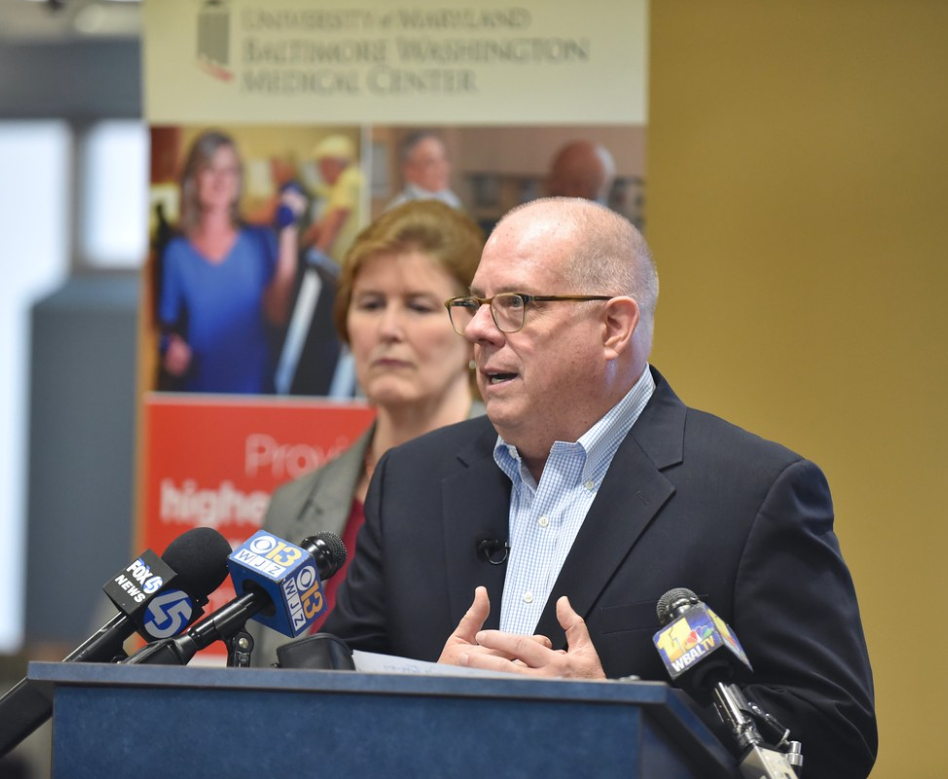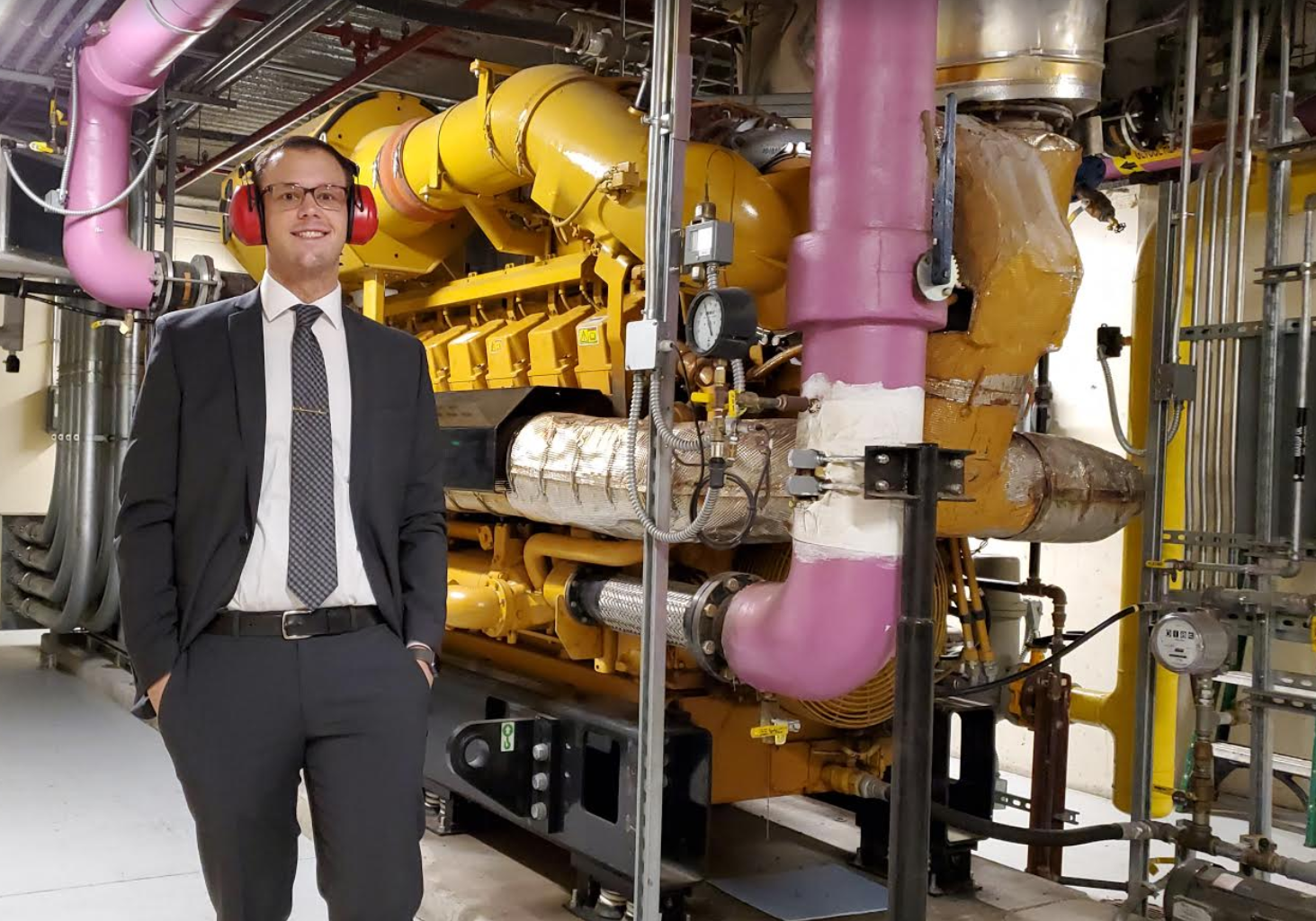Governor Hogan Tours Baltimore Washington Medical Center’s Combined Heat & Power System + Announces New Energy Legislation

from left BWMC VP of Operations Sue Ward, BWMC Senior Project Manager Laura Kautz, MEA Director Mary Beth Tung, BWMC CEO Karen Olscamp, Governor Larry Hogan, Secretary Ben Grumbles, MEA Programs Director Eric Coffman, MEA CHP Manager Brandon Bowser photo credit Maryland GovPics
Yesterday, Governor Hogan, along with members of the Maryland Energy Administration (MEA) toured the facilities at Baltimore Washington Medical Center (BWMC) in Glen Bernie, to see their combined heat and power (CHP) system. Part of the University of Maryland (UMM) hospital network, BWMC is one of three UMMs healthcare campuses in the state to have a Combined Heat and Power (CHP) system installed.
CHP systems combine technologies to maximize energy efficiency and reduce waste. In traditional fossil fuel power plants, two-thirds of the energy used to generate electricity is wasted in the form of heat discharged to the atmosphere as well as through electricity transmission, achieving a combined efficiency of only 33 percent. By combining electricity generation and waste heat capture, CHP systems can operate at levels as high as 75 – 80 percent efficiency. MEA’s fiscal year 20 CHP grant has $4.2 million dollars available and the grant deadline is February 12, 2020.

BWMC’s Laura Kautz explaining the to Governor Hogan how the CHP powers the hospital to run efficiently year round photo credit Maryland GovPics
BWMC’s CHP system powers the hospital’s lights and machines in the operating rooms, and utilizes previously lost heat to keep BWMC temperatures comfortable year-round. This system is powered by natural gas, as opposed to burning diesel fuel to make electricity. Additionally, the CHP system provides reliable energy in times of need, this CHP system can be used as a backup generator with the medical center’s other emergency generators during weather emergencies or disasters.

This CHP system saves 13.9 million kWh per year, 2,700 MMBtu natural gas per year, and operates at 77.2% HHV efficiency photo credit Maryland GovPics
The total cost of system of the BWMC CHP system was $8 million and was funded by the hospital plus a $1.75 million dollar rebate from Baltimore Gas and Electric Co. and a $465,000 dollar MEA CHP grant. The annual energy savings for this system are$750,000 dollars or 13.9 million kWH or natural gas energy savings of 2,695 MMBtus. The system operates at 77.2 percent efficiency plus, the annual carbon saved is around 10,000 tons, equivalent to removing 1,800 passenger cars off the road. However UMMs has three of these CHP systems in place.

Governor Hogan presented BWMC an official citation in recognition of their progressive stance in energy efficiency, waste reduction and green house gas reduction photo credit Maryland GovPics
Besides this system in Glen Burnie, there is also a system in Bel Air at the University of Maryland Upper Chesapeake Health and in Towson at University of Maryland St. Joseph Medical Center. The total energy and cost savings within UMMs is more than $1.5 million annually in total utility costs across the UMMS footprint . The three UMMS CHP installations have generated over 100,000,000 (one hundred million) kilowatt hours of electricity combined. All of the sites have participated in the BGE Smart Energy Savers Rebate program, saving approximately $4 million through production incentives. Plus, UMMs is still looking forward with more CHP and energy savings with possible projects at Baltimore’s University of Maryland Medical Center and construction on the new University of Maryland Medical Center in Largo will also include a CHP system.

Governor Hogan addresses local media on new energy advances for Maryland photo credit Maryland GovPics
While at BWMC, Governor Hogan also announced bold new energy legislation that is cleaner, smarter and cheaper with net-zero carbon. Under the Clean and Renewable Energy Standard (CARES), Maryland will have 100% Clean Electricity by 2040 and still protect Maryland jobs and our environment. CARES builds upon Maryland’s Renewable Portfolio Standard (RPS) to provide a strategy for Maryland to achieve better environmental results through clean energy. It expands the eligibility of credits for clean energy resources to encourage competition and cost-effectiveness for the benefit of all Marylanders who pay for electricity. Unlike previous efforts to clean-up Maryland’s energy strategy, CARES will not increase residential or business electricity bills.
“Over the last five years, Maryland has become a national leader in energy efficiency and affordable clean energy measures that prioritize the needs of our citizens and the environment,” said Director Tung. “CARES will address the carbon elephant in the room by providing a clear path for Maryland’s net-zero carbon future with projects like the combined heat and power system at Baltimore Washington Medical Center.”
Governor Hogan first introduced CARES in May of 2019 and will submit the full CARES plan on the first day of the upcoming legislative session in January 2020.
Key elements include:
- Increasing the strategic use of zero- and low-carbon clean and renewable energy sources.
- Recognizing the clean and safe aspects of nuclear energy by making new nuclear energy facilities, such as small modular reactors built utilizing developing technology, eligible for clean energy credits.
- Supporting hydropower, coupled directly with maintaining environmental stewardship.
- Providing incentives for carbon capture, utilization, and storage, making Maryland the first state to do so.
- Encouraging energy-efficient combined heat and power systems by making new facilities eligible for credits.
- Eliminates the eligibility of these credits and subsidies for controversial energy resources such as “black liquor” and the burning of municipal solid waste to create energy.
CARES provides the means to vastly enhance the production of low carbon and carbon-free energy in Maryland and highlights the environmental stewardship of the Hogan administration in our energy sector while providing Marylanders with affordable, reliable, and cleaner energy.


 1-888-373-7888
1-888-373-7888 233733
233733